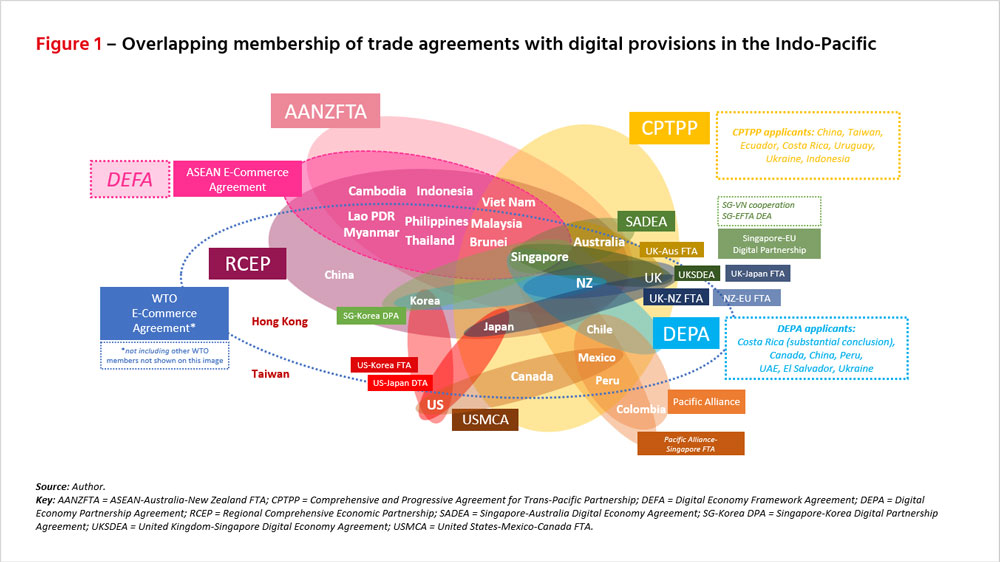ASEAN has set an ambitious goal to establish a comprehensive regional digital economy agreement by the end of the year. Despite strong political support for greater economic integration, Southeast Asian countries remain divided on key issues such as data flows, data protection, tariffs, and AI regulations. While the ASEAN Digital Economy Framework Agreement (DEFA) is crucial, it is uncertain how effectively it can reconcile the differences within ASEAN on digital trade rules.

In today’s complex geopolitical environment, economic fragmentation is a growing and undesirable risk. For ASEAN, mitigating these forces is of paramount importance. Projected to become the world’s fourth-largest economy by 2030, ASEAN has benefitted from over 50 years of regional integration efforts that have connected its ten member-economies. Equally vital to its success is its outward-facing network of trade relationships, supported by a rules-based multilateral trading system. As individual nations, ASEAN members lack significant economic and political power, but by collaborating, ASEAN has the potential to not only increase intra-regional trade but also influence global norms.
This is especially evident in the digital domain. By 2030, ASEAN’s digital economy is expected to grow to US$1 trillion, up from US$300 billion today. The proposed ASEAN Digital Economy Framework Agreement (DEFA) could double this figure. DEFA’s provisions on digital trade could increase ASEAN’s exports of services and digital services by up to 45%, contributing about 2% of the region’s GDP and creating nearly 6 million jobs. The digitalization of supply chains under DEFA could increase goods trade by 74%, or US$326 billion, in new trade flows.
ASEAN’s Vision for a New Digital Trade Framework
How can DEFA deliver on these ambitious projections? ASEAN Digital Ministers have set high expectations, aiming to create a “coherent, harmonized, collaborative, and rules-based approach” to establish an open, secure, interoperable, competitive, and inclusive regional digital economy. They envision using DEFA to position ASEAN as a pioneering region that secures a legally binding agreement for a unified digital economy. The challenge will be whether ASEAN can meet this ambitious goal by the 2025 deadline, especially within the current geoeconomic context.
Digital Trade Barriers: Recycled Issues in New Forms
Discriminatory digital trade barriers are on the rise, including in ASEAN. The OECD’s Digital Services Trade Restrictiveness Index reveals that some of the fastest-growing markets, like Vietnam, Indonesia, Cambodia, and Laos, are particularly restrictive regarding cross-border data flows, which are essential to digital trade. Such restrictions can hinder businesses’ ability to access markets, add value, and maintain the integrity of transactions, undermining consumer trust.
New obstacles to digital trade also arise from mismatched standards, systems, and regulatory frameworks—barriers that stem more from poor design than protectionism—and from “regulatory overdrive” and the complicated landscape of emerging digital trade provisions. Some ASEAN countries are also concerned about the influx of cheap e-commerce goods and have responded by lowering de minimis limits (the threshold below which goods don’t incur tariffs) and raising import duties.
Another significant threat, expected to materialize at the 2026 World Trade Organization Ministerial Conference, is the potential for countries to impose tariffs on “electronic transmissions” (a term that remains vaguely defined but likely covers digital services)—the so-called “e-commerce moratorium.” Indonesia, a leading ASEAN economy, is a strong advocate for new tariffs. Such tariffs could disproportionately impact small ASEAN businesses and overall economic growth.
In contrast, well-structured digital trade rules, supported by cooperation and knowledge-sharing among partners, can reduce barriers, enhance market access predictability, lower compliance costs, and build confidence among regulators, businesses, and investors. This is where DEFA could prove crucial.
Enter DEFA
The DEFA negotiating framework covers nine core areas: data flows and protection, trade facilitation, e-commerce, electronic payments and invoicing, digital identities and authentication, cybersecurity, competition policy, emerging technologies, and “talent mobility and cooperation.” The latter is a new concept in digital trade but could offer ASEAN more agility and innovation by tapping into its large human capital resources.
ASEAN has a solid track record of strategic digital economy initiatives, including an E-Commerce Agreement, but DEFA represents a significant step forward. It could foster greater regulatory alignment, lock in best practices, and serve as a benchmark for the region, reducing compliance costs and business obstacles. DEFA could also provide a foundation for future AI interoperability, where fragmented policies and regulatory landscapes are a major concern, particularly given changes from the new US administration. ASEAN Digital Ministers announced in January 2025 that they would cooperate more closely on AI policies, governance, laws, regulations, standards, and industry engagement, potentially translating these efforts into tangible results through DEFA.
DEFA in the Broader Digital Trade Rules Landscape

How does DEFA fit within the broader landscape of digital trade rules? As illustrated in Figure 1, the Indo-Pacific is filled with overlapping and divergent digital trade agreements, with ASEAN economies participating in varying degrees.
The provisions and scope of these agreements differ greatly. At one end of the spectrum are deals like the Comprehensive and Progressive Agreement for Trans-Pacific Partnership (CPTPP), which includes binding rules on data flows, forced data localization, personal information protection, trade facilitation, and consumer protection. The ASEAN-led Regional Comprehensive Economic Partnership (RCEP) takes a similar approach but allows more policy flexibility on data governance.
At the other end are new digital-first agreements that encourage cooperation on various digital economy issues, alongside core CPTPP- or RCEP-style rules. These “digital economy agreements,” largely initiated by Singapore, tackle issues that are still being understood and, while flexible, could inadvertently lead to new frictions between markets.
DEFA as a Potential Regional Bridge
Can DEFA bridge the gaps between these regional models? Despite strong political backing, progress is likely to be difficult, especially on regulatory areas with significant differences, such as data flows, data protection, tariffs, and AI regulations—issues that are critical for commercial interests.
A potential roadblock may be Indonesia’s opposition to including binding rules against tariffs on digital trade in DEFA. However, given Indonesia’s recent application to join the CPTPP, which prohibits tariffs on electronic transmissions, some flexibility may emerge.
ASEAN Digital Ministers acknowledged in January that the digital divide, cross-border data flows, cybersecurity, and rapid technological changes present ongoing regulatory challenges. They also emphasized the growing importance of protecting sensitive personal data while creating a more secure, innovative, and inclusive digital economy for ASEAN businesses, consumers, and societies.
It remains uncertain how these divergent positions will be reconciled. For some issues, such as tariffs or forced data localization, the positions have already been debated extensively, making it difficult to move ASEAN away from the flexibility offered by RCEP and similar agreements. Differences in infrastructure, regulatory environments, and economic priorities present fundamental challenges to harmonized rules. As for emerging issues like AI, the landscape remains fluid, which may discourage ASEAN from taking definitive positions at this stage.
This raises questions about whether ASEAN can meet its ambitious 2025 deadline. Past ASEAN agreements have often taken longer to conclude than the two years DEFA aims for. Less economically advanced ASEAN members, as well as those with large informal sectors, will need to build capabilities to ensure that the benefits of digital transformation are widely shared, potentially pushing back the implementation timeline.
The Importance of DEFA Despite the Challenges
Despite these challenges, DEFA remains critically important. Efforts to create more integrated, predictable, and business-friendly trade policy frameworks are valuable. Even small improvements can strengthen the digital economy, boost business opportunities, and enhance the resilience of Southeast Asia, while supporting long-term domestic reforms. Additionally, DEFA could have geopolitical benefits, as ASEAN—through its collective efforts—can potentially establish a new baseline for digital trade rules in the region, influencing global negotiations, such as those surrounding the WTO e-commerce agreement.


